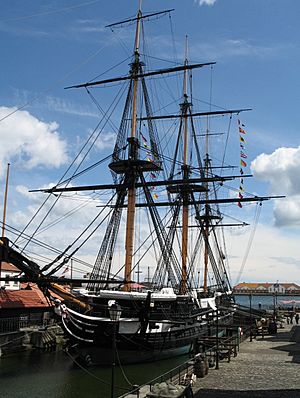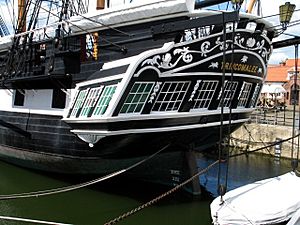HMS Trincomalee facts for kids

Trincomalee in her current location in Hartlepool
|
|
Quick facts for kids History |
|
|---|---|
| Name | HMS Trincomalee |
| Operator | National Museum of the Royal Navy |
| Ordered | 30 October 1812 |
| Builder | Wadia Group |
| Cost | £23,000 |
| Laid down | 25 April 1816 |
| Launched | 12 October 1817 |
| Out of service | 1986 |
| Renamed |
|
| Homeport | National Museum of the Royal Navy, Hartlepool, England |
| Status | Museum ship |
| General characteristics | |
| Class and type | Leda-class frigate |
| Tons burthen | 1065.63 bm |
| Length |
|
| Beam | 39 ft 11.25 in (12.1730 m) |
| Depth of hold | 12 ft 9 in (3.89 m) |
| Sail plan | Full-rigged ship |
| Complement | 315 officers and men |
| Armament |
|
HMS Trincomalee is a historic Royal Navy sailing frigate. She was built right after the Napoleonic Wars, a series of major conflicts in Europe. Today, she is a fully restored museum ship that floats in the National Museum of the Royal Navy in Hartlepool, England.
Contents
The Ship's Early Life
Building a Warship in India
Trincomalee is one of only two British frigates from her time that still exist. Her sister ship, HMS Unicorn, is also a museum ship in Dundee, Scotland. Trincomalee was ordered on October 30, 1812. She was built in Bombay, India, by the Wadia Group, a famous family of shipbuilders. They used strong teak wood because there wasn't enough oak in Britain. This shortage was due to all the ships being built for the Napoleonic Wars. The ship was named Trincomalee after the 1782 Battle of Trincomalee, which happened near a port of the same name in Ceylon (now Sri Lanka).
From Launch to Reserve
Work on Trincomalee started in May 1816. During a special ceremony, the master shipbuilder, Jamsetjee Bomanjee Wadia, hammered an engraved silver nail into the ship's keel. This was an important Parsi Zoroastrian tradition, believed to bring good luck to the ship. Building Trincomalee cost about £23,000. She was launched on October 12, 1817.
Commander Philip Henry Bridges sailed her to Portsmouth Dockyard in England. The journey cost £6,600, and she arrived on April 30, 1819. On her first trip, the ship stopped at Saint Helena for six days in January 1819. She even picked up a passenger there: Mr. John Stokoe, a surgeon who had cared for Napoleon on the island. After spending another £2,400 to get ready, Trincomalee was put into the reserve until 1845. This meant she was kept ready but not actively used. In 1845, she was updated with fewer, but more powerful, guns. Her back end was also reshaped, and she became known as a sixth-rate spar-decked corvette.
Active Service and Training Role
Adventures at Sea
Trincomalee left Portsmouth in 1847 and served for ten years. She sailed to the North America and West Indies Station, which covered a large area of the Atlantic. During this time, she helped calm down unrest in Haiti and stopped a possible invasion of Cuba. She also worked to stop the illegal slavery trade. In 1849, she went to Newfoundland and Labrador before returning to Britain in 1850. In 1852, she joined the Pacific Squadron on the west coast of America. When she returned to England in 1857, she was again put "in ordinary," meaning she was taken out of active service.
Becoming a Drill Ship
In 1860, Trincomalee was prepared for a new role. In January 1861, she was towed to Sunderland to become a "tender" ship for HMS Castor (1832). This meant she supported Castor, which was a drill ship. Drill ships were used to train young Naval Volunteers, boys aged 15 to 16, who signed up to serve for 10 years once they turned 18. During this time, Trincomalee's gunports (the openings for guns) were changed several times to fit different types of training weapons. In 1862, she moved to West Hartlepool, which was then the third-largest port in Britain. She was moored in the Union Dock and became an independent drill ship.
A New Name and a New Life
From Trincomalee to Foudroyant
Trincomalee finished her time with the Royal Navy as a training ship. She was put back into the reserve in 1895 and then sold for scrap metal in 1897. However, an entrepreneur named Geoffry Wheatly Cobb bought her. He had her restored and renamed her Foudroyant. This new name honored HMS Foudroyant, an earlier ship he owned that had been wrecked in 1897.
The ship was used along with HMS Implacable as a place for people to live, a training ship, and even a holiday ship. She was first based in Falmouth and then in Milford Haven. Her move caused some sadness in Falmouth. By 1954, she was based in Portsmouth Harbour.
She continued in this role until 1986. After that, she was restored again and given her original name, Trincomalee, back in 1992.
A Living Museum Ship
Today, Trincomalee is part of the National Historic Fleet. After her most recent restoration, she became the main attraction at the National Museum of the Royal Navy in Hartlepool.
Trincomalee holds a special record: she is the oldest British warship that is still floating! While HMS Victory is 52 years older, she is kept in a dry dock and not afloat. The Falmouth-based painter Henry Scott Tuke often used the ship and its trainees as subjects for his paintings until he passed away in 1929.
Gallery
See also
- HMS Victory – An 18th-century ship of the line
- USS Constitution – An 18th-century US Navy frigate
- HMS Unicorn – A surviving sister ship to Trincomalee
- Historical Maritime Society








